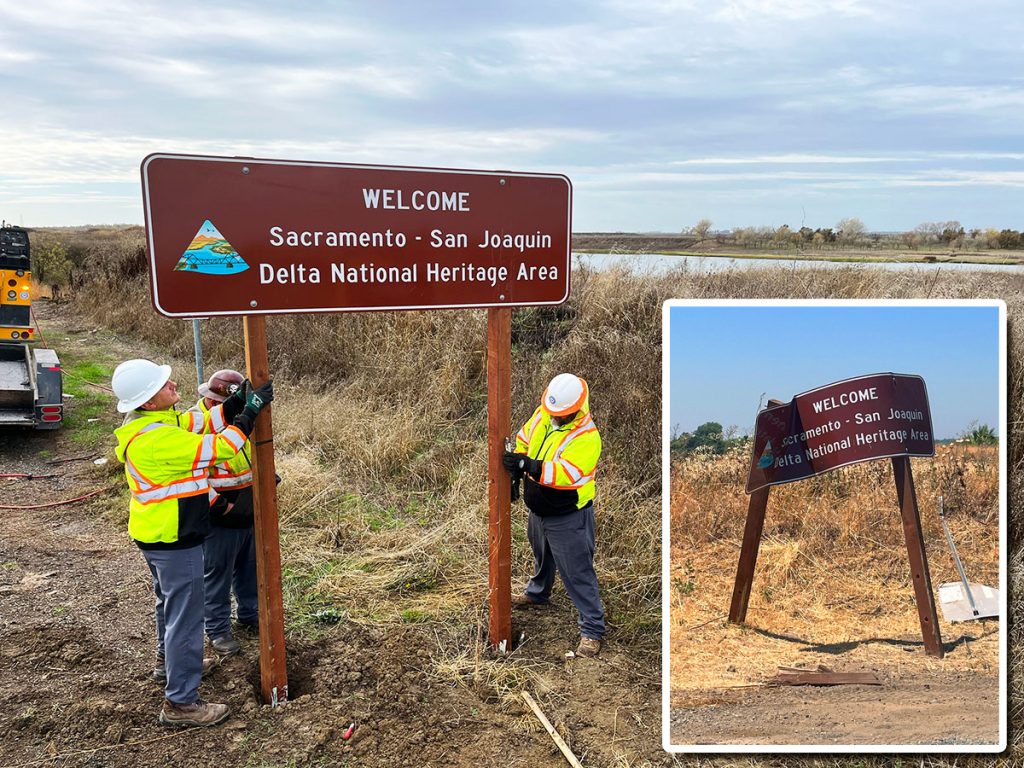The NHA Sign Is Back … and Here’s Why We’re Excited About It

A Yolo County Public Works crew installs the replacement for a sign damaged when it was hit by a car in July. Located on Jefferson Boulevard just outside of West Sacramento, the new sign is a little farther from its original location on the curve where Jefferson goes up on the levee, ideally making it less likely to get hit again.
WEST SACRAMENTO, Calif. (Dec. 13, 2023) – A Delta National Heritage Area sign on Jefferson Boulevard outside of West Sacramento was replaced Dec. 7 after being destroyed in a non-injury car accident in July, just weeks after it had been installed.
Why does it matter?
Delta communities have warmly welcomed these signs, which are a project of the Delta Protection Commission – the agency coordinating the Sacramento-San Joaquin Delta National Heritage Area.
Three of eleven planned signs have been installed so far.
Why these signs are important to people?
Signs tell you something important is ahead.
California is filled with internationally renowned destinations that are announced on freeway signs often from hundreds of miles away: San Francisco, Lake Tahoe, Yosemite, Los Angeles.
And, typically, the closer you get, the larger those destinations loom as their skyscrapers, mountain peaks, and trees reach for the sky.
But in a place as flat as the Delta, how would a visiting motorist know what lies ahead? By definition, its landmarks are low-profile: a lacework of rivers, 100-year-old bridges, tiny communities built by early settlers from around the globe, and farm stands offering some of the best produce in America.
Signs are the only way a visitor – and many Northern Californians – would know what’s there.
And how often do signs announce you’re entering a rural area worth exploring, making you think twice about just speeding through on your way somewhere else?
Not very often. That’s why the Delta has welcomed these signs.
Whom do we have to thank for these signs?
In addition to the Delta Protection Commission, the following agencies have also been involved in this project: the Delta Stewardship Council; the Sacramento-San Joaquin Delta Conservancy; Caltrans districts 3, 4 and 10; the California Conservation Corps; California Prison Industry, which made the signs; and the Yolo County Public Works crew that installed the replacement sign.
When will the remaining eight signs be installed?
Five signs slated for San Joaquin County will be installed by Caltrans District 10. The signs will be located at Walnut Grove Road at I-5, Highway 12 at I-5, Highway 4 just outside of Stockton, I-5 south of Lathrop, and the I-205/I-580 split.
Two more signs in Sacramento County – one on Twin Cities Road off of I-5 and another on Highway 12 outside of Rio Vista – are targeted for installation by Caltrans District 3 in spring or early summer of 2024.
The Commission is still working to find a partner to install the sign planned for Highway 4 in Pittsburg.
Click here to see a map of current and planned sign locations.
Why does it take so long to install signs?
The process requires several layers of permits, approvals, and contracts for design, fabrication, location, and installation.
The fact that this phase of the sign project spans four counties and three Caltrans districts adds to the complexity.
And even when an installation has been fully approved, delays are common with projects involving work on busy freeways and highways.


